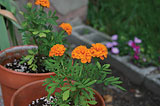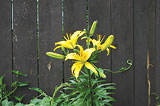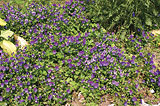
photos by Cecil Bothwell
|
Summer has arrived at The North Carolina Arboretum. It brings with it this year’s seasonal landscape exhibit, populated by colorful blossoms of all seasons tucked into beds and planted in containers, baskets and buckets.
The memorable fragrances, colors and textures of the featured plants — arranged to demonstrate reproducible design — annually inspire new and advanced gardeners.
This year’s theme, “A Time to Celebrate,” marks 10 years of seasonal exhibits as well as the arboretum’s 20th anniversary and the completion of its first capital campaign.
So which plants have joined the party? Herbs, grasses, perennials, vines and shrubs are all on display. Basil, parsley, dill, pineapple mint and sweet marjoram are growing in containers for the Savory Thyme Cafe, whose staff is busily dreaming up ways to use pinches and snippets of these delicious culinary herbs in new dishes. Fountain grass, Carex and fiber optic grass round out containers with their fine textures.
There are also some surprise guests: We often don’t think of using woody plants in summer containers, since there are so many other choices for summer color. However two such plants are worth noting. Allamanda, a vigorous tropical vine, typically has a yellow, trumpet-shaped flower. Yet “Cherries Jubilee”, the cultivar used in our containers, has lavender-red flowers that provide great contrast to the yellow-green, spiny fruit that develops once the flower fades.
 |
Arboretum staffers are looking forward to seeing “Limelight” do its thing. This new panicle hydrangea has lime-green flowers and upright stems that hold up well through the summer months. As fall arrives, many turn pink and burgundy, creating quite a show with all three colors present at once.
Sometimes it’s simple color combinations that makes a container sing. When I think of the red-flowering Allamanda along with golden creeping Jenny and a new Coleus with vibrant lime-green foliage patterned with deep purple lines called “Fishnet Stockings”, my skin tingles. The bright-yellow flowers of the trailing petunia, set against the multihued yellow-and-green foliage of Iresine (commonly called chicken gizzard plant), support the focal plant, a soft-leaf yucca with yellow-and-green stripes and large spikes of creamy white blooms.
For the more subdued, we have the wide, crimson blades of the “Red Sensation” Cordyline nestled with a compact form of sweet, vanilla-scented heliotrope, the peachy-yellow, lobelialike flowers of Monopsis, and the miniature blue, petunialike flowers of Nolana.
Textures are also important for contrast and fun in container design. The use of the fine-bladed “Prairie Fire” Carex in combination with the palm-sized, pancake-shaped leaves of the aptly named Kalanchoe “Flap Jacks” is striking. This same effect is achieved when “Flap Jacks” is used with the lower-growing fiber optic grass.
One of my favorite combinations this year for color and texture is a new variety of Euphorbia called “Diamond Frost”. Its small, airy-white flowers form clouds in and among the rosy pink-and-white, multicolored petunia called “Flambe”. Whenever I pass by, I look deep within the foliage, hoping to find small fairies and elves basking in its beauty.
 |
This year’s quilt pattern is Log Cabin, a popular traditional block pattern easily recognized by its center square surrounded by rectangular strips. Bright-blue Ageratum, yellow-flowering Bidens and “Kiwi Fern” Coleus, with its yellow-edged purple foliage, bring this cabin to life in the garden.
The plantings in front of the Visitor Education Center are sure to delight the eye. Pink and purple Angelonia, garnet-purple “Black Heart” sweet potato, the “Flambe” petunia and two double forms of zinnia make up the backbone of this planting. It’s interwoven with a new flowering tobacco, or Nicotiana, called “Perfume Deep Purple”. This All-American selection for 2006 tops out at 20 inches and is loaded with star-shaped, deep-purple flowers that fill the garden with sweetness.
If some of these names are unfamiliar to you, you’re not alone. Many of these plants are new to the market or simply may not have a common name. Many have never before been seen or used here, and a few will be difficult to find in the retail market. Although this may be frustrating when your “I have got to have this” voice goes off, this is the beauty of what the arboretum offers: a way to help connect the gardener with new plants looking to make their way into the market.
In fact, the arboretum’s horticulture-and-design staff is working with six different national and international seed companies to support their research-and-development programs by helping evaluate more than 50 different varieties — both new and old. Staff and volunteers will be collecting quantifiable data to evaluate specific plants for their overall performance, insect and disease resistance, and general appeal in the mountains of Western North Carolina. Results will be reported to the companies. If this effort interests you, please come out and take time to make your own notes; feedback is always welcome. Stop by the front desk and ask the volunteer at the front desk for your own evaluation form.
And if you’d rather just relax and enjoy the exhibit, you can still learn new ways in to bring more color, interest and fun into your garden and your life.
[Alison Arnold is director of horticulture at The North Carolina Arboretum. She can be reached at 665-2492.]


Before you comment
The comments section is here to provide a platform for civil dialogue on the issues we face together as a local community. Xpress is committed to offering this platform for all voices, but when the tone of the discussion gets nasty or strays off topic, we believe many people choose not to participate. Xpress editors are determined to moderate comments to ensure a constructive interchange is maintained. All comments judged not to be in keeping with the spirit of civil discourse will be removed and repeat violators will be banned. See here for our terms of service. Thank you for being part of this effort to promote respectful discussion.